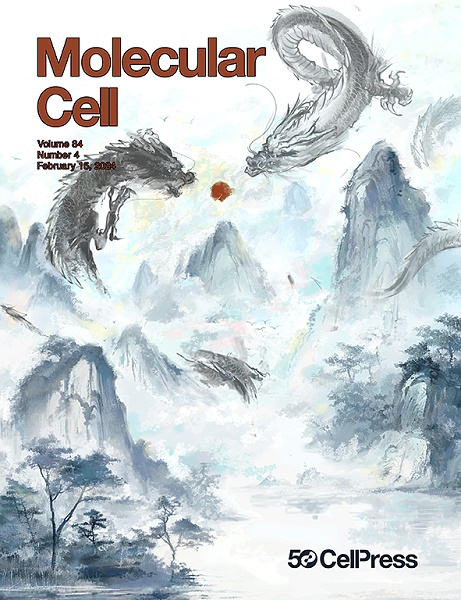JNK 磷酸化改变了 BRD4 的功能
IF 14.5
1区 生物学
Q1 BIOCHEMISTRY & MOLECULAR BIOLOGY
引用次数: 0
摘要
溴结构域 4(BRD4)是一种具有多种功能的关键调控因子,在癌症和细胞应激反应中发挥着至关重要的作用。它具有双重功能:染色质结合的 BRD4 通过其组蛋白乙酰转移酶(HAT)活性调节重塑,而启动子相关的 BRD4 则通过其激酶活性调节转录。值得注意的是,与染色质结合的BRD4缺乏激酶活性,与RNA聚合酶II(RNA Pol II)结合的BRD4没有HAT活性。这项研究揭示了BRD4功能转换的一种机制。在各种刺激下,c-Jun N-末端激酶(JNK)介导的人类 BRD4 在 Thr1186 和 Thr1212 处的磷酸化会引发其从染色质中的短暂释放,从而破坏其 HAT 活性并增强其激酶活性。释放的 BRD4 直接与 RNA Pol II、PTEFb 和 c-Myc 相互作用并使其磷酸化,从而促进参与免疫和炎症反应的靶基因的转录。JNK 介导的 BRD4 功能转换可诱导胸腺细胞中 CD8 的表达和前列腺癌细胞中上皮细胞向间质转化(EMT)。这些发现阐明了BRD4从染色质调节剂转变为转录激活剂的机制。本文章由计算机程序翻译,如有差异,请以英文原文为准。

Phosphorylation by JNK switches BRD4 functions
Bromodomain 4 (BRD4), a key regulator with pleiotropic functions, plays crucial roles in cancers and cellular stress responses. It exhibits dual functionality: chromatin-bound BRD4 regulates remodeling through its histone acetyltransferase (HAT) activity, while promoter-associated BRD4 regulates transcription through its kinase activity. Notably, chromatin-bound BRD4 lacks kinase activity, and RNA polymerase II (RNA Pol II)-bound BRD4 exhibits no HAT activity. This study unveils one mechanism underlying BRD4’s functional switch. In response to diverse stimuli, c-Jun N-terminal kinase (JNK)-mediated phosphorylation of human BRD4 at Thr1186 and Thr1212 triggers its transient release from chromatin, disrupting its HAT activity and potentiating its kinase activity. Released BRD4 directly interacts with and phosphorylates RNA Pol II, PTEFb, and c-Myc, thereby promoting transcription of target genes involved in immune and inflammatory responses. JNK-mediated BRD4 functional switching induces CD8 expression in thymocytes and epithelial-to-mesenchymal transition (EMT) in prostate cancer cells. These findings elucidate the mechanism by which BRD4 transitions from a chromatin regulator to a transcriptional activator.
求助全文
通过发布文献求助,成功后即可免费获取论文全文。
去求助
来源期刊

Molecular Cell
生物-生化与分子生物学
CiteScore
26.00
自引率
3.80%
发文量
389
审稿时长
1 months
期刊介绍:
Molecular Cell is a companion to Cell, the leading journal of biology and the highest-impact journal in the world. Launched in December 1997 and published monthly. Molecular Cell is dedicated to publishing cutting-edge research in molecular biology, focusing on fundamental cellular processes. The journal encompasses a wide range of topics, including DNA replication, recombination, and repair; Chromatin biology and genome organization; Transcription; RNA processing and decay; Non-coding RNA function; Translation; Protein folding, modification, and quality control; Signal transduction pathways; Cell cycle and checkpoints; Cell death; Autophagy; Metabolism.
 求助内容:
求助内容: 应助结果提醒方式:
应助结果提醒方式:


